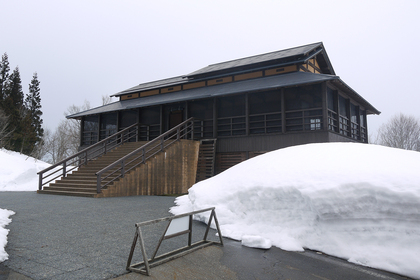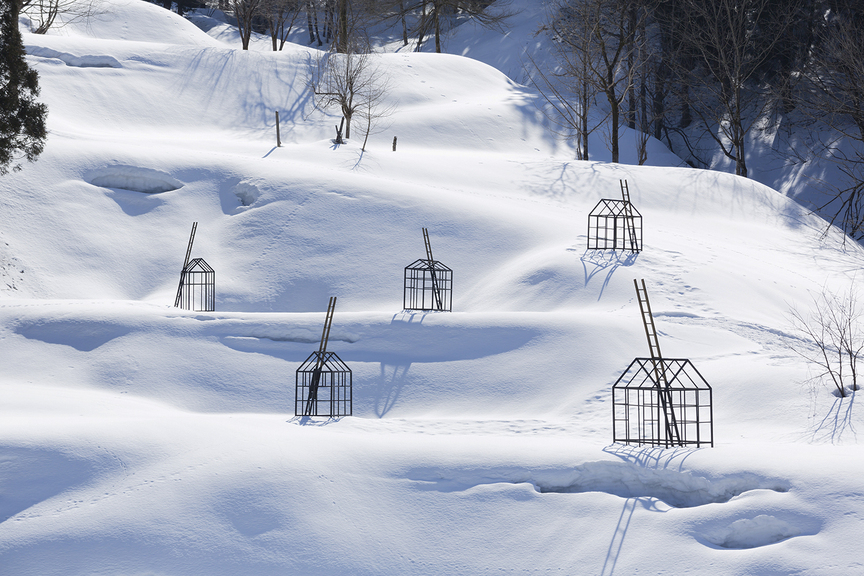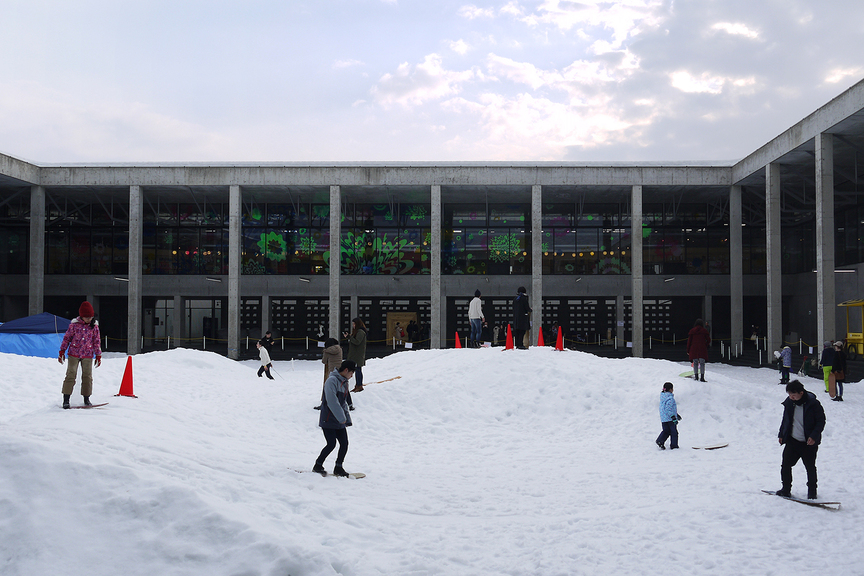
R
E
V N
E
X
T
View of the snow-blanketed Japanese Alps in Echigo-Yuzawa, Niigata prefecture, en route to the Echigo-Tsumari art field. All photos by Ysabelle Cheung for ArtAsiaPacific unless otherwise specified.
Starting in December every year, miles of arable pastures in Niigata prefecture, Japan, begins transformation from fragrant, jade-green grasslands to misty, powdery snow country. Stretching from southwest to northeast along the Sea of Japan, the area’s hibernation under meters of snow is an annual event and is caused by clouds pushing against the mountain ranges of Honshu island; the humid fog is then perforated by Siberian breezes, resulting in thick, dreamy blizzards.
This also explained the dramatic and sudden change from a dry and brisk wintry landscape into sleepy snowfall, which was visible as soon as the train pulled into the station from Tokyo. The Nobel-prize-winning writer Yasunari Kawabata, who wrote the novel Snow Country (1947), allegedly based on the months he spent lodged in a Niigata ryokan (traditional “inn”), opens his story with the mysterious lines: “The train came out of the long border tunnel—and there was the snow country. The night had turned white.”
Every three years, in six areas within Niigata, the popular Echigo-Tsumari Art Triennale (ETAT) takes place in the summer months, and is a remarkable example of commercial Tokyo-based Art Front Gallery and Triennale director Fram Kitagawa’s public art philosophy, in which harmonious biological diversity in rural, underpopulated chunks of Japan should be cultivated in tandem with and merging with the growth of contemporary art. Since its inaugural edition in 2000, ETAT has invited international and local artists to contribute to 190,000 acres of crops, hills and terraced rice fields, which are already dotted with over 800 permanent installations including Yayoi Kusama’s dotted flower sculpture, Tsumari in Bloom (2003)—which the artist has mentioned is her favorite public artwork—and a fully functional Kawanishi house designed by James Turrell, where his apertures and light displays riff off the architecture of Japanese-style living quarters.
In the months between ETAT, however, the region also hosts a summer mini-festival and the winter SnowArt activities. The two are organized according to the ETAT motto: “In summer, cultivate the fields; in winter, cultivate the mind.” Winter activities are focused on exploration and interaction with contemporary art. From February 25 through March 12, visitors can hike the “SnowArt Trail” behind the Matsudai Nohbutai Gallery to view site-specific works, most only installed during the winter months; and partake in celebrations of spring’s imminent arrival, such as the yearly edition of Gift for Frozen Village by Kyota Takahashi in Tokomachi, for which 22,000 glowing multi-colored lights were embedded in the snow to accompany a fireworks show on March 4, a date which marks the end of winter.
Museums in the area remain open during the winter months as well, and many draw visits from families with activities for young children. At Matsudai’s Echigo-Tsumari Satoyama Museum of Contemporary Art, which will begin to rotate its exhibitions regularly starting from 2018, kids were eagerly lining up to spray-paint and customize wooden snowboards, which they used to slide around the mini-course within the open-air center of the museum. A narrow ice-skating rink was flanked by an exhibition depicting the ongoing study project, “Homestay Museum,” where researchers live in local homes to archive and document changing domestic culture as a result of rapid modernization.
Once the snow begins to fall away, artworks are reinstalled or emerge naturally from their hiding places. When in full bloom during ETAT, the region is bustling. However, the persistence and urgency of contemporary art is still visible even in snow, in direct contrast with Kawabata’s descriptions of the region being one of loneliness. In a forest of perfumed evergreens, Mori No Hibi (2017) by Kyota Takahashi saw light bulbs softly dimming on and off in 98 wooden frames, referencing breathing patterns and sending a quiet, bright message of life still moving under and with the snow.
The seventh Echigo-Tsumari Art Triennale takes place from end of July to mid September in 2018.
Ysabelle Cheung is managing editor at ArtAsiaPacific.
To read more of ArtAsiaPacific’s articles, visit our Digital Library.






